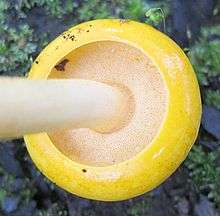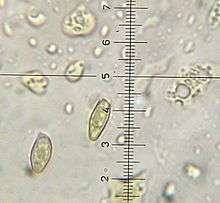Boletus curtisii
Boletus curtisii is a species of fungus in the Boletaceae family. It produces small- to medium-sized fruit bodies (mushrooms) with a convex cap up to 9.5 cm (3.7 in) wide atop a slender stem that can reach a length of 12 cm (4.7 in). In young specimens, the cap and stem are bright golden yellow, although the color dulls to brownish when old. Both the stem and cap are slimy or sticky when young. On the underside of the cap are small circular to angular pores. The mushroom is edible, but not appealing. It is found in eastern and southern North America, where it grows in a mycorrhizal association with hardwood and conifer trees. Once classified as a species of Pulveroboletus, the yellow color of B. curtisii is a result of pigments chemically distinct from those responsible for the yellow coloring of Pulveroboletus.
Taxonomy
The species was first described scientifically by English mycologist Miles Joseph Berkeley in 1853.[2] The specific epithet curtisii honors Moses Ashley Curtis,[3] who collected the type material from South Carolina.[2]
American mycologist William Murrill called it Ceriomyces curtisii in 1909,[4] but Ceriomyces (as defined by Murrill in 1909) has since been subsumed into Boletus.[5] In his 1947 monograph on boletes of Florida, Rolf Singer transferred the species to the genus Pulveroboletus, and made it the type of his newly described section Cartilaginei, which featured species with a glutinous or sticky stem, and a leather-colored to brownish hymenophore.[6] Species in Pulveroboletus are characterized by the presence of pigments based on the chemical structure of pulvinic acid, a yellow-orange compound found in some species of Boletales.[7] The pigments responsible for the color of B. curtisii are, however, entirely different from the pulvinic acid compounds found in Pulveroboletus species, which invalidates the chemotaxonomical rational for generic placement in Pulveroboletus.[8] Otto Kuntze once placed the species in Suillus, but it lacks the partial veil and glandular dots associated with that genus.[9] William Chambers Coker and Alma Beers considered Charles Horton Peck's Boletus inflexus (described from New York in 1895[10]) as well as Henry Curtis Beardslee's 1915 B. carolinensis to be the same species as B. curtisii.[11] Coker and Beer's suggested synonymy, however, is not recognized by the taxonomical authorities MycoBank or Index Fungorum.[1][12]
Wally Snell once considered Boletus carolinensis to be the sames species as B. curtisii. He claimed that the former species was then considered distinct from the latter by virtue of an even, instead of reticulate (netlike) stem, although they were otherwise quite similar in appearance and spore size and shape.[13] Snell explained that although neither the English nor the Latin text of Berkeley's original description mentioned a reticulated stem, a later (1872) description by Berkeley characterized the stem as reticulato.[14] Snell thought that this might have been an error in transcription, or an error in the species account, as herbarium specimens that he had examined lacked this feature.[13] He changed his mind a couple of years later, when he found a small amount of reticulation in material collected by Peck.[15]
Description

The cap is 3–9.5 cm (1.2–3.7 in) wide, and initially obtuse to convex in shape before becoming broadly convex to nearly flat when mature. The cap margin has a narrow band of sterile tissue that in young fruit bodies is curved inwards. The cap surface is somewhat sticky when fresh, smooth, and bright yellow to orange-yellow, sometimes with brownish tints or whitish areas in age. The whitish flesh does not change color when exposed to air, and has no distinctive odor or taste. On the underside of the cap, the pore surface is initially whitish to buff or pale yellow, but becomes duller and darker at maturity, often depressed near the stem in age. Unlike some other boletes, B. curtisii does not turn blue when bruised or injured. The pores are circular to angular, and there are 2–3 per mm; the tubes are 6–12 mm deep.[16] Young fruit bodies usually have droplets of golden yellow liquid on the pore surface (sometimes abundantly so), although this is rarely observed in older specimens.[17]
The stem is 6–12 cm (2.4–4.7 in) long, 0.6–1.3 cm (0.2–0.5 in) thick, and roughly equal in width throughout. Its surface is sticky and glutinous when fresh, somewhat scurfy near the apex (covered with loose scales) but smooth below. It is pale yellow to yellow down to the base, which is sheathed with a cottony white mycelium. The stem can be either solid or hollow. The mushroom lacks a partial veil and a ring. The spore print is olive-brown.[16] The mushroom is edible, but not appealing.[3]

Spores are 9.5–17 by 4–6 μm, ellipsoid to somewhat ventricose (inflated on one side), smooth, and yellowish.[16] The basidia (spore-bearing cells) are four-spored, measuring 25–32 by 6–10.8 μm. The cystidia lining the inside of the tubes are shaped like setae (i.e., thick walled and thorn-like) and have dimensions of 43–86 by 6.5–11 μm. All hyphae lack clamp connections.[6]
Similar species
Retiboletus retipes is somewhat similar in appearance, but is distinguished by a more orange to orange-yellow color, a lack of sliminess, and a distinctly reticulated stalk.[3]
Habitat and distribution
The fruit bodies of B. curtisii grow singly, scattered, or in small groups on the ground in coniferous or mixed woods, often with pines. Fruit bodies generally appear from August to November. The geographical distribution of the fungus is limited to eastern and southern North America. In the United States, it occurs from New England south to Florida, and west to Texas.[16] The species was newly reported from Mexico in 2001.[18]
Pigments
The fruit bodies of Boletus curtisii contain a unique series of derivatives of the molecule canthin-6-one. Before this discovery, canthin-6-one alkaloids were only known from higher plants.[8] Among the canthin-6-one derivatives are the pigments that give the mushroom its bright yellow color, including two optically active sulfoxides named curtisin and 9-deoxycurtisin.[19] Spraying a fruit body with methanol causes the pigments to dissolve and makes the color wash away—a phenomenon unknown in other bolete mushrooms.[8] Additionally, spraying fruit bodies with acetone results in a green-yellow fluorescence visible in daylight.
See also
References
- 1 2 "Boletus curtisii Berk. 1853". MycoBank. International Mycological Association. Retrieved 2011-10-14.
- 1 2 Berkeley MJ, Curtis MA (1853). "Centuries of North American fungi". Annals and Magazine of Natural History. 12 (2): 417–35 (see p. 429).
- 1 2 3 Metzler V, Metzler S (1992). Texas Mushrooms: A Field Guide. Austin, Texas: University of Texas Press. p. 217. ISBN 0-292-75125-7.
- ↑ Murrill WA. (1909). "The Boletaceae of North America: II". Mycologia. 1 (4): 140–58. doi:10.2307/3753125. JSTOR 3753125.
- ↑ Kirk PM, Cannon PF, Minter DW, Stalpers JA (2008). Dictionary of the Fungi (10th ed.). Wallingford, UK: CAB International. p. 128. ISBN 978-0-85199-826-8.
- 1 2 Singer R. (1947). "The Boletoideae of Florida with notes on extralimital species III". American Midland Naturalist. 37 (1): 1–135 (see pp. 18–19). doi:10.2307/2421647. JSTOR 2421647.
- ↑ Gill M, Steglish W (1987). "Pigments of fungi (Macromycetes)". Progress in the Chemistry of Organic Natural Products. 51: 1–17. doi:10.1007/978-3-7091-6971-1_1. PMID 3315906.
- 1 2 3 Bröckelmann MG, Dasenbrook J, Steffan B, Steglich W, Wang YK, Raabe G, Fleischhauer A (2004). "An unusual series of thiomethylated canthin-6-ones from the North American mushroom Boletus curtisii" (PDF). European Journal of Organic Chemistry. 2004 (23): 4856–63. doi:10.1002/ejoc.200400519.
- ↑ Kuo M, Methven A (2010). 100 Cool Mushrooms. Ann Arbor, Michigan: University of Michigan Press. p. 31. ISBN 978-0-472-03417-8.
- ↑ Peck CH. (1895). "New species of fungi". Bulletin of the Torrey Botanical Club. 22: 198–211 (see p. 207). doi:10.2307/2478162.
- ↑ Coker WC, Beers A (1972) [1943]. The Boleti of North Carolina (reprint ed.). New York, New York: Courier Dover Publications. ISBN 0-486-20377-8.
- ↑ "Homotypic synonyms: Boletus curtisii Berk.". Index Fungorum. CAB International. Retrieved 2012-08-21.
- 1 2 Snell WH. (1934). "Notes on Boletes. III". Mycologia. 26 (4): 348–59. doi:10.2307/3754231. JSTOR 3754231.
- ↑ Berkeley MJ. (1872). "Notices of North American fungi". Grevillea. 1 (3): 35.
- ↑ Snell WH. (1936). "Notes on Boletes. IV". Mycologia. 28 (1): 13–23. doi:10.2307/3754063. JSTOR 3754063.
- 1 2 3 4 Bessette AE, Roody WC, Bessette AR (2000). North American Boletes. Syracuse, New York: Syracuse University Press. pp. 106–7. ISBN 978-0-8156-0588-1.
- ↑ Snell WH, Dick EA. The Boleti of Northeastern North America. Lehre, Germany: J. Cramer. p. 62.
- ↑ Jiménez JG, Ocañas FG (2001). "Conocimiento de los hongos de la familia Boletaceae de México" [Knowledge of the fungi family Boletaceae of Mexico] (PDF). Ciencia UANL (in Spanish). 4 (3): 336–44. ISSN 1405-9177.
- ↑ Jiand M-K, Feng T, Liu J-K (2011). "N-containing compounds of macromycetes". Natural Product Reports. 28: 783–808. doi:10.1039/C0NP00006J.
External links
- Boletus curtisii in Index Fungorum
- Mushroom Expert Description and images
- Mushroom Observer Images
